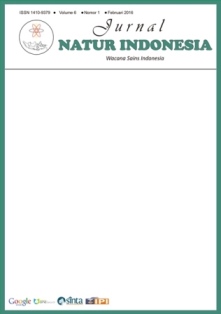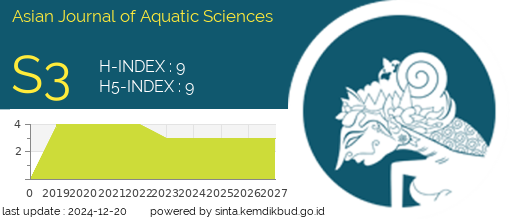Analysis of Mangrove Forest Changes Using Satellite Image Data on Rupat Island
DOI:
https://doi.org/10.31258/jnat.23.1.50-57Keywords:
Mangrove Vegetation Index, Citra Landsat, Density, MangroveAbstract
Mangrove forest vegetation is spread across several islands in Indonesia, including Rupat Island. Rupat Island is the outermost island in Riau Province, close to Malaysia, and directly faces international waters, namely the Malacca Strait. Rupat Island has two sub-districts, namely Rupat District and North Rupat District. Rupat Island has a very extensive mangrove forest and has a significant contribution. Monitoring changes in mangrove forests is one way of controlling the mangrove forest ecosystem. This research aims to analyze changes in mangrove vegetation area and mangrove density using the MVI algorithm in 2013 and 2023 on Rupat Island, Bengkalis Regency. This research was conducted in the mangrove forest ecosystem on Rupat Island, Bengkalis Regency, Riau Province. The method used in this research is a survey method with observation and field data collection (ground check). Based on image processing results, the area of mangrove vegetation was 13903.03 ha (2013) to 11748.66 ha (2023) and experienced a reduction of 2154.37 ha. Classification based on MVI in sparse density has an area of 5872.46 ha (2013), decreasing to 3422.05 ha (2023); medium density has an area of 2188.84 ha (2013), increasing to 3334.64 ha (2023), and dense density has an area of 5841.73 ha (2013) reduced to 4991.97 ha. Over 10 years, the density of mangrove vegetation has increased in the medium class and tends to decrease in the sparse and dense classes. Based on calculations, the density of mangroves on Rupat Island falls into the tree category, ranging from 1150.00 ind/ha to 1450.00 ind/ha, which is considered good, and the sapling category ranges from 366.67 ind/ha to 1050.00 ind/ha, which is classified as good.
Downloads
References
Achmad, E., Nursanti, N., Marwonto, M., Fazriyas, F., Dwi, P., Jayanti, J., 2019. Studi kerapatan mangrove dan perubahan garis pantai tahun 1989-2018 di Pesisir Provinsi Jambi. Journal of Natural Resources and Environmental Management, 10(2): 138-152.
Agusrinal, A., Santoso, N., Prasetyo, L.B., 2015. Tingkat degradasi ekosistem mangrove di Pulau Kaledupa, Taman Nasional Wakatobi. Silvikultur Jurnal Indonesia, 6(3): 139-147.
Andana, E.K., 2015. Pengembangan data citra satelit Landsat-8 untuk pemetaan area tanaman hortikultura dengan berbagai metode algoritma indeks vegetasi (Studi kasus: Kabupaten Malang dan Sekitarnya). Prosiding Seminar Nasional Manajemen Teknologi XXII: C 15-1 - C 15-10. Surabaya, Indonesia.
Baloloy, A.B., Blanco, A.C., Sta, A.R.R.C., Nadaoka, K., 2020. Development and application of a new Mangrove Vegetation Index (MVI) for rapid and accurate mangrove mapping. ISPRS Journal of Photogrammetry and Remote Sensing, 166: 95–117.
Batubara, R., Affandi, O., 2017. Nilai ekonomi hasil hutan non kayu dan kontribusinya terhadap pendapatan rumah tangga (Studi kasus pada dua desa sekitar taman wisata Sibolangit). Jurnal Kehutanan, 12(2): 149-162.
Habibie, L.Z., Khurniawan, D., Dewi, C.S.U., 2021. Monitoring kondisi mangrove di Pesisir Gebang Kabupaten Sidoarjo dengan menggunakan metode MVI pada citra satelit sentinel-2. Fisheries and Marine Science,
Hotden, H., Khairijon, K., Isda, M.N., 2014. Analisis vegetasi mangrove di ekosistem mangrove Desa Tapian Nauli I Kecamatan Tapian Nauli Kabupaten Tapanuli Tengah Provinsi Sumatera Utara. JOM FMIPA, 1(2): 40-49.
Kementerian Lingkungan Hidup & Kehutanan., 2019. Rehabilitasi mangrove dalam rangka pengelolaan ekosistem lestari. Workshop Pengelolaan Mangrove Berkelanjutan dengan Pendekatan Berbasis Ekosistem: Potret Upaya Konservasi dan Rehabilitasi di Indonesia. Purwokerto.
Kusmana, C., Sukristijiono, S., 2016. Mangrove resources uses by local community in Indonesia. Jurnal Pengelolaan Sumberdaya Alam dan Lingkungan, 6(2): 218 – 224.
Onrizal, O., 2008. Panduan pengenalan dan analisis vegetasi hutan mangrove. Universitas Sumatera Utara. Medan.
Puspita, D., Mubarak, M., Nursyirwani, N., 2021. Analysis of coastline changes in Rupat Island using remote sensing data and geographic information systems. Asian Journal of Aquatic Sciences, 4(3): 236-246.
Sampurno, R.M., Thoriq, A., 2016. Klasifikasi tutupan lahan menggunakan citra landsat 8 Operational Land Imager (OLI) di Kabupaten Sumedang. Jurnal Teknotan, 10(2): 62-68.
Suyono, S., Supriharyono, S., Hendrarto, B., Radjasa, O.K., 2015. Pemetaan degradasi ekosistem mangrove dan abrasi pantai berbasis geographic information system di Kabupaten Brebes, Jawa Tengah. Oceatek, 9(01): 90–102.
Downloads
Published
Issue
Section
License
Copyright (c) 2025 Dinda Roanna Agusti, Mubarak Mubarak, Efriyeldi Efriyeldi, Rifardi Rifardi, Aras Mulyadi, Zulkifli Zulkifli, Ilham Ilahi (Author)

This work is licensed under a Creative Commons Attribution 4.0 International License.





